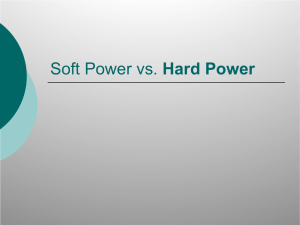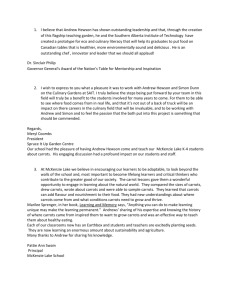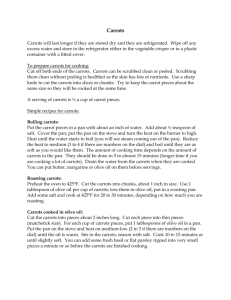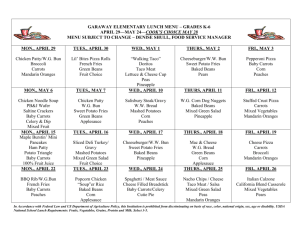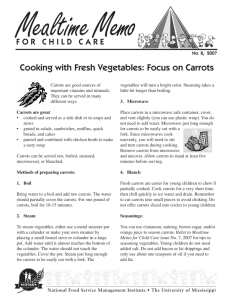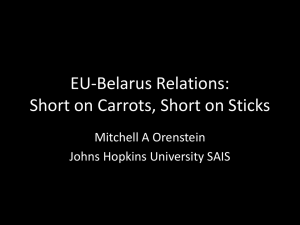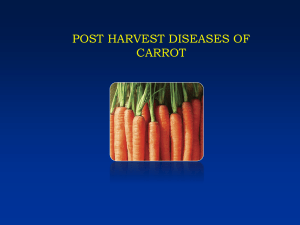Product specifications Carrots
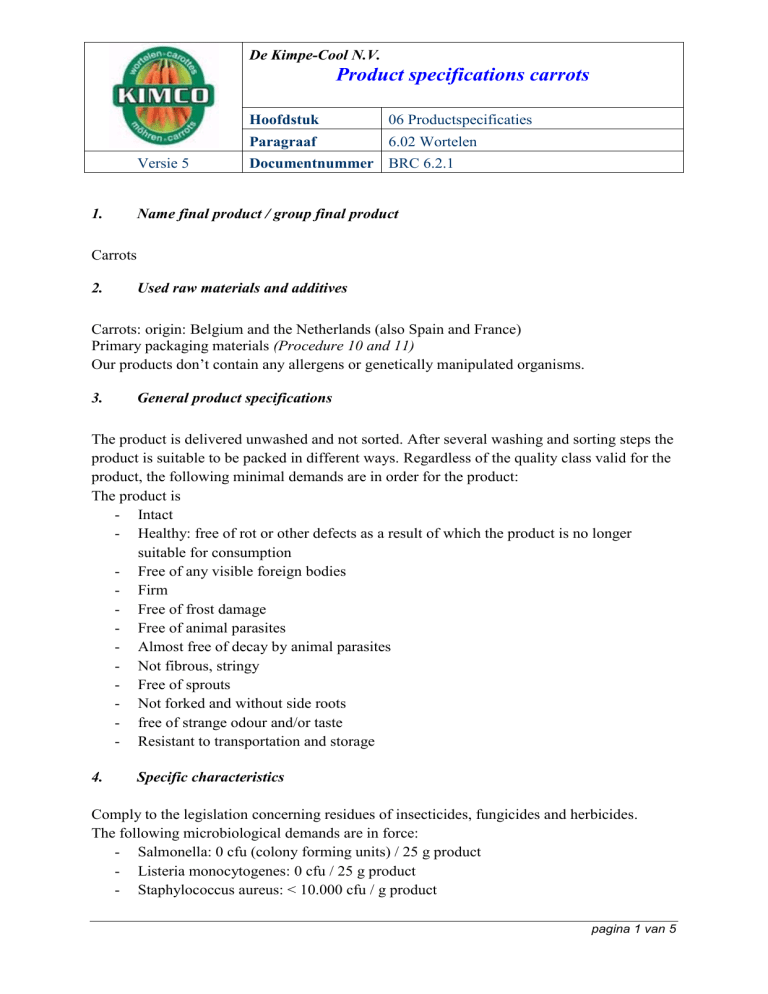
De Kimpe-Cool N.V.
Product specifications carrots
Versie 5
Hoofdstuk
Paragraaf
06 Productspecificaties
6.02 Wortelen
Documentnummer BRC 6.2.1
1.
Carrots
Name final product / group final product
2. Used raw materials and additives
Carrots: origin: Belgium and the Netherlands (also Spain and France)
Primary packaging materials (Procedure 10 and 11)
Our products don’t contain any allergens or genetically manipulated organisms.
3. General product specifications
The product is delivered unwashed and not sorted. After several washing and sorting steps the product is suitable to be packed in different ways. Regardless of the quality class valid for the product, the following minimal demands are in order for the product:
The product is
Intact
Healthy: free of rot or other defects as a result of which the product is no longer suitable for consumption
Free of any visible foreign bodies
Firm
Free of frost damage
Free of animal parasites
Almost free of decay by animal parasites
Not fibrous, stringy
Free of sprouts
Not forked and without side roots
free of strange odour and/or taste
Resistant to transportation and storage
4. Specific characteristics
Comply to the legislation concerning residues of insecticides, fungicides and herbicides.
The following microbiological demands are in force:
Salmonella: 0 cfu (colony forming units) / 25 g product
Listeria monocytogenes: 0 cfu / 25 g product
Staphylococcus aureus: < 10.000 cfu / g product pagina 1 van 5
De Kimpe-Cool N.V.
Product specifications carrots
Hoofdstuk
Paragraaf
06 Productspecificaties
6.02 Wortelen
Versie 5 Documentnummer BRC 6.2.1
Bacillus cereus: < 10.000 cfu / g product
Clostridium perfringens: < 10.000 cfu / g product
Escherichia Coli: < 100 cfu / g product
Comply to the legislation concerning heavy metals.
For carrots the following maximal values are in place:
lead: maximal value 0.1 mg/kg product
cadmium: maximal value 0.1 mg/kg product
Analysis- and sampling frequency
See BRC Procedure 24
5. Specific demands
Calibre
28-40 mm/26-32 mm/20-28 mm/15-20 mm
6. Packages
Big bags (+/- 1000 kg)
Polyethylene bags: 1/ 1.5/ 2/ 3/ 5/ 10 kg
Net bags: 5/ 10 kg
Polypropylene bags: 0.5/ 1/ 1.5 kg
Trays: 1 kg
Bulk in crates: 12/ 12.5/ 15/ 20 kg
Optimal storage conditions 7.
Refrigerated between 1 - 4 °C
Note: the carrots are refrigerated at 1°C, when stored during winter
8. Specific shelf life
Due to life long experience with production of carrots we can say the following concerning shelf life of carrots:
Depending of the season or period carrots can remain suitable for consumption from 4 weeks until 3 months when stored in refrigerators (+/- 0.5 - 2°C). When stored above 4°C they remain suitable for consumption for 2 weeks. Carrots for storage during the winter have a longer shelf life than early harvested carrots. pagina 2 van 5
De Kimpe-Cool N.V.
Product specifications carrots
Hoofdstuk
Paragraaf
06 Productspecificaties
6.02 Wortelen
Versie 5 Documentnummer BRC 6.2.1
9. Consumer target group
All consumers
-
9.1 Known abuse
10. Relevant law and legislation
Procedure law and legislation (BRC1.1)
11. Nutritional value
Average nutritional value
Energy
Proteins
Carbohydrates
Starch
Fibre content
Moisture content
Fat content
Minerals
Sodium
Potassium
Iron
Calcium
Phosphor
Magnesium
Zinc
Copper
Vitamins
Provitamin A
Vitamin B1
Vitamin B2
Vitamin C
/ 100 g product
28 kcal / 119 kJ
0.4 g
6.7 g
0.2 g
3.2 g
91 g
<0.1 g
38 mg
233 mg
0.30 mg
30 mg
35 mg
8 mg
0 mg
0 mg
1067 µg
0.04 mg
0.04 mg
4 mg pagina 3 van 5
De Kimpe-Cool N.V.
Product specifications carrots
Hoofdstuk
Paragraaf
06 Productspecificaties
6.02 Wortelen
Versie 5 Documentnummer BRC 6.2.1
12. Physical en chemical characteristics
Specific heat (20°C) / piece
Specific gravity (20°C) / piece
Heat conduction coefficient (20°C)/ piece
Specific gravity (20°C) / bulk
3890 J/(kgK)
1014 kg/m³
0.56 J/(sm²C)
500 kg/m³
Heat conduction coefficient (20°C) / bulk
Melting point / freezing point (1 bar)
0.33 J/(sm²C)
-1.4°C
13. Extra information
Het dry matter content D.M. (%) is the ratio between the mass of the dried material and the mass of the fresh material and is calculated as follows:
(Md)
D.M. = ------- x 100
(Mn)
D.M.: Dry Matter content (%)
Md: Mass of the dried sample (g)
Mn: Mass of the fresh sample (g)
The dry matter content of carrots is in general dependent of different factors:
Variety:
Fast-growing varieties have in general less dry matter than slow-growing varieties
Type of carrot: for example “Amsterdamse bak” types have a lower dry matter content than “Flakkeese” types
The D.M. of certain varieties is also increased through oriented breeding schemes and results in new varieties
Type of soil:
Carrots that grow on light (sandy) soils have a lower D.M. than these on heavier soils
(loam and clay)
Fertilizing:
Heavy fertilized (mostly nitrogen) soils result in a faster growth and a lower D.M. than less fertilized soils
Cultivation season:
During a season with enough rain and warmth the D.M. will be lower than during a dry and cold season pagina 4 van 5
De Kimpe-Cool N.V.
Product specifications carrots
Hoofdstuk
Paragraaf
06 Productspecificaties
6.02 Wortelen
Versie 5
Ripeness of the crops:
Documentnummer BRC 6.2.1
A fully ripe crop has a higher D.M. than a young, early harvested crop. A crop looses fluids during storage and this also results in a higher D.M.
These factors can influence each other which means these statements aren’t unambiguous with combination of different factors.
An absolute number of D.M. is always related to the factors that can influence it. To compare
D.M. it is necessary to measure different samples under the same conditions.
It is assumed that ripe carrots have a D.M. between 8.5 and 13.5%.
These advices are based on our best information and experience. We are not responsible for any consequences due to these advices. pagina 5 van 5

